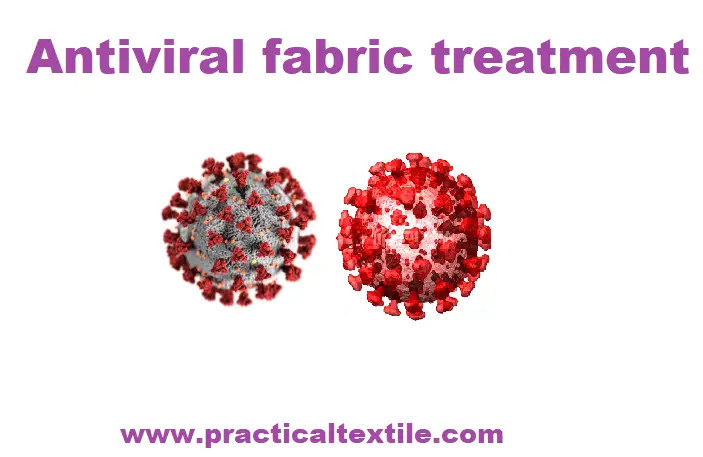
Antiviral fabric treatment in textile processing is now the main topic of textile finishes. Textile products supply the maximum hosting area for viruses and bacteria. So that fabric can supply bacteria and viruses to the skin of the human body. As a result, pathogens create in the skin. So needs treatment to destroy these pathogens.
Virus: the virus is nothing but a submicroscopic infectious agent which infects specific cells of plants, animals, and humans. It is a harmful infectious that creates diseases. More than viruses are enveloped by fatty, lipid, and cholesterol membrane. The other 40% of the virus is Non-Enveloped. Various sizes 20-300nm. Examples: Coronavirus, Human and avian influenza virus (H1N1, H5N1), Herpes simplex virus, Hepatitis virus, HIV.
Bacteria: Bacteria is a single-cell organism. A large number of bacteria are present inside and outside of the human body. Most of the bacteria are harmless and some are harmful. Sze is normally 1000nm. Example: Staphylococcus aureus, MRSA, MSSA; Gram neg. Escherichia coli, Klebsiella pneumoniae, Salmonella typhimurium
Why do we need antiviral fabric treatment?
- Textiles provide a large hosting surface for viruses and bacteria.
- Textile directly contacts human skin.
- Various can survive a day to a month on the fabric surface.
- Research shows that human coronavirus (covid 19) can live for up to 2 days at room temperature.
So to destroy this kind of virus and bacteria this antiviral and anti-bacterial treatment is so essential.
Fabrics on which antiviral treatment can be done:
- All types of non-woven fabrics like face masks, air filters, medical nonwovens (e.g. surgical gowns, drapes, etc.),
- Applies on workwear in hospitals and care facilities,
- On bed sheets and liners,
- Curtains,
- Carpets and room furnishings.
- Even all fabrics in daily use like terry towels and apparel in general.
Application of antiviral agent on knitted fabric:
Application of Antiviral agents can be done in both continuous and exhaust methods. This antiviral agent will be active for up to 30 wash.
Application of antiviral agent in the exhaust system:
ANTI-VIRAL Dyeing and FINISH PROCESS
Scouring and Bleach
⇓
Enzyme
⇓
Dyeing
⇓
Soaping 90⁰C, Runtime=10
⇓
80⁰C*10 (Normal hot)
⇓
Check absorbency
⇓
Control PH 4.5-5.
⇓
Dose 30⁰C *5-Antiviral agent 2%(Depends on the concentration of chemical)
⇓
Increase Temp to 60⁰C (grading 1⁰C)
⇓
Runtime 30 min
⇓
Cooling 40⁰C
⇓
Drain & Unload
⇓
Slitting
⇓
Stenter: 1st bath 40 to 50g/l durable softener
⇓
Temperature: 120⁰C
⇓
Stenter: 2nd bath Water only
⇓
Compacting
⇓
Delivery to cutting
Application of antiviral agent in the Standard continuous system:
ANTI-VIRAL Dyeing and FINISH PROCESS
Scouring and Bleach
⇓
Enzyme
⇓
Dyeing
⇓
Soaping 90⁰C, Run=10
⇓
80⁰C Run=10 (Normal hot)
⇓
Check absorbency
⇓
Drain & Unload
⇓
Slitting
⇓
Stenter: 1st bath Anti viral agent 50-120 G/L, Temperature: 120⁰C to 140⁰C Ph= 4.5 to 5
⇓
Stenter: 2bath Durable softener 40 to 50 G/L
⇓
Compacting
⇓
Delivery to cutting
How can antiviral fabric treatment be tasted?
There are three steps established to test this treatment:
Step 1: Silver content analysis: AAS Industry standard (Amount of silver content on the textiles is analyzed)
Step 2: Antibacterial test: If passed, then: ISO 20743 antimicrobial test of staphylococcus.
Step 3: Antiviral test: ISO 18184
Conclusion antiviral fabric treatment:
Antiviral fabric treatment in textiles is a special advanced technique. Nowadays, it is so essential fabric treatment for preventing coronavirus. So that it is an essential treatment all over the world.
Research link:
You may read some other articles:
- Knit Dyeing & Finishing Process Flow Chart 2022
- Standard Operating Process (SOP) Flow Chart Of Garments Finishing
- Standard Scouring & Bleaching Process in textile Or SOP Of Scouring and Bleaching Of Knit Fabric According To Fiber Type
- Types of Textile Testing List For Quality Control In The Textile Industry Are Explained In This Guide
You can find us on: